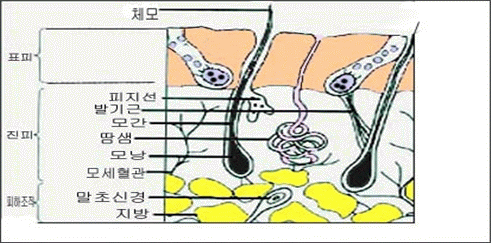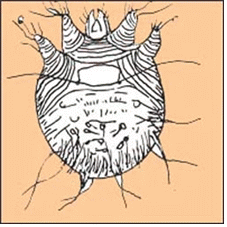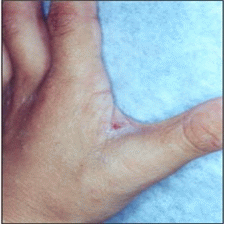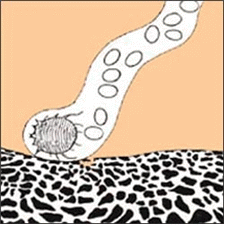옴(개선/개선증), Scabies
옴(개선/개선증)의 원인

그림 402.피부 구조도와 마이트 감염(옴)
Copyright ⓒ 2012 John Sangwon Lee, MD., FAAP

그림 403. 옴을 일으키는 마이트(옴벌레)
Copyright ⓒ 2012 John Sangwon Lee, MD., FAAP

사진 404. 손가락 사이 피부에 생긴 옴 피부염이 있다.
Copyright ⓒ 2012 John Sangwon Lee, MD., FAAP
-
진드기 목(目)에 속하는 옴 벌레(Sarcoptes scabiei/마이트/Mite) 감염으로 인한 피부 감염병을 옴, 또는 개선증이라 한다.
-
옴을 일으키는 옴벌레를 소양 진드기 또는 옴 진드기라고도 한다.
-
옴벌레는 작은 모래알만 하고 다리가 8개 달려 있다.
-
옴벌레는 0.2~0.5mm 정도 길고 육안으로는 잘 볼 수 없고 현미경으로 쉽게 볼 수 있다.
-
옴벌레는 세계 각처에서 발견되고 빈부귀천 남녀노소 가릴 거 없이 누구에게나 감염될 수 있다.
-
특히 병원, 데이케어, 어린이 집, 감옥, 수용소 등에서 집단생활 하는 아이들이나 성인들에게 더 잘 감염되기 쉽고, 비위생적이고 밀집 거주 환경에서 사는 아이들에게 감염률이 더 높다. 특히 영유아들이나, 노인들, 노숙자들에게 이환율이 높다.
-
성충 암컷 옴벌레가 피부의 각질층에 감염되어 피부층 속에 굴을 파고 기어 다니면서 옴 피부염을 일으킨다(그림 402 참조).
-
과거 한 때 옴이 세계 각처에 두루 퍼져 있었다.
-
그 후 얼마 동안 옴이 이 세상에서 거의 없어진 듯 했다가 요새 다시 전 세계적으로 대유행하고 있다.
-
옴벌레는 주로 팔목 굴절 피부, 팔목 신전 피부, 겨드랑이 피부, 대퇴부위 피부, 허리 피부, 엉덩이 피부, 외음부 피부, 복부피부 등 의 피부층의 각질층에 감염되어 거기서 기생한다.
-
다른 사람의 피부에 접촉될 때 마이트에 감염될 수 있다.
-
암컷 옴벌레는 피부의 각질층 속에서 굴을 파고 기어 다니면서(1일 2mm 정도 파고 다닐 수 있다) 여러 개의 알을 낳고 한두 달 동안 살 수 있다.
-
인체 밖에서는 72시간 내외 동안 살 수 있다.
-
굴을 파고 기어 다닐 때는 심하게 가려울 수 있다.
-
옴벌레의 평균 수명은 1~2개월이다.
-
옴 치료로 피부 각질층 속 옴 벌레가 죽거나 늙어 자연적으로 죽은 옴벌레 단백질 알레르기로 심하게 가려울 수 있다.
-
옴이 요즘 미국을 비롯한 선진국의 사람들에게 생길 수 있다.
-
옴벌레가 성교로 다른 사람에게 감염될 수 있다. 옴은 성교 관련 감염성 성병에 속 한다.
-
개 등 애완동물로부터 동물 옴벌레에 감염될 수 있다.

그림 405. 마이트 감염병(옴)
Copyright ⓒ 2012 John Sangwon Lee, MD. FAAP
옴(개선/개선증)의 증상 징후
-
중증도, 감염된 신체의 부위, 합병증의 유무, 나이 등에 따라 증상 징후가 다르다.
-
옴벌레가 피부에 감염되었다고 해서 금방 가려운 증상 징후가 생기는 것은 아니다.
-
잠복기는 4~6주이나 재 감염될 때는 4∼6일 정도이다.
-
옴벌레가 피부 각질층 속에서 굴을 파고 다닐 때 가려운 증상 징후가 주로 생긴다.
-
구진이 생길 수 있고 파도처럼 선상으로 구진이 생길 수 있다.
-
옴벌레 단백질 알레르기로 더 많이 가려울 수 있다.
-
신체의 모든 부위에 있는 피부에서 기생할 수 있으나 손·발·발가락 사이·발바닥·팔다리·얼굴·몸·머리·가랑이·겨드랑이 등 피부에 더 잘 감염될 수 있다.
-
첫 돌 이전 영아들의 엉덩이, 기저귀 찬 부위나 머리 등에 잘 감염되어 작고 큰 물집이 잡힐 수 있다.
-
밤낮 가릴 것 없이 가려워 긁을 수 있으나 밤에 더 가렵다.
-
가려워서 긁으면 붉은 피부 발진이 생긴다.
-
심하게 가려울 때 긁으면 진물이 나고 피가 날 수 있다.
-
2차 세균 감염이 상처에 생기면 그 부위가 곪고 감염성 농가진이 생길 수 있고 종기가 날 수 있다.
-
또 그 주위 림프절이 비대되고 림프절염도 생길 수 있다.
-
피부가 벗겨질 수 있고 플라크가 생길 수 있다.
-
속히 치료해 주지 않으면 옴벌레가 몸 전체의 피부에 퍼질 수 있고 다른 사람들에게 감염될 수 있다.
옴(개선/개선증)의 진단
-
병력·증상 징후와 진찰소견 등을 종합해 진단한다.
-
발진이 생긴 피부 각질의 일부를 의료 기구로 긁어 수집해 피검 물을 현미경으로 검사해 성충 마이트나 알을 찾아 진단할 수 있다.
-
집안 식구들 중 한 사람이 옴에 옮을 때는 다른 식구들도 옴에 옮을 수 있다.
옴(개선/개선증)의 치료
-
국소용 펄메스린(Permethrin) 크림,
-
경구용 ivermectin
-
린덴(Lindane),
-
크로타미톤(Crotamiton),
-
감마 벤진 헥사클로라이드(γBenzeneHexa-chloride) 등 옴 치료용 로션, 크림, 또는 샴푸 국소 치료를 한다. 몸 옴은 로션으로, 머리 옴은 샴푸로 치료한다.
-
1차 치료한 후 2∼5일 후에 다시 한 번 더 치료하면 완치되는 것이 보통이다.
-
다른 식구들은 옴에 옮아 있지 않은 것 같아도 같은 날 한 집안 식구들 모두 다 같이 치료받아야 한다.
-
집 안에서 기르는 개나 고양이도 역시 동시 치료받아야 한다.
-
치료 할 때 홑이불이나 속옷 등을 삶아 세탁하고 다른 깨끗한 옷으로 갈아입어야 한다.
-
옴 치료약에 따라 다르지만, 옴 치료약으로 치료한 8~24시간 후 치료에 썼던 옴 치료약을 목욕해 다 닦아내야 한다.
-
자주 만나 노는 친구들도 가능한 한 같은 날에 치료받게 한다.
-
심하게 가려울 때는 아타락스나 베나드릴 등 1세대 항히스타민, 또는 타이레놀 등으로 치료한다.
-
엘로콘이나 베타메타손, 또는 다른 종류의 코르티코스테로이드제 연고를 가려운 국소에 발라 치료할 수 있다.
Scabies
Causes of scabies

Figure 402. Skin structure diagram and mite infection (scabies) Copyright ⓒ 2012 John Sangwon Lee, MD., FAAP

Figure 403. Mite that causes scabies (scabies) Copyright ⓒ 2012 John Sangwon Lee, MD., FAAP

Picture 404. Scabies dermatitis on the skin between the fingers. Copyright ⓒ 2012 John Sangwon Lee, MD., FAAP
• Skin infections caused by scabies (Sarcoptes scabiei/mite/Mite) belonging to the tick order are called scabies or amelioration.
• The scabies that cause scabies are also called pruritus mites or scabies mites. • Scabies is the size of a small grain of sand and has eight legs.
• Scabies is 0.2~0.5mm long and cannot be seen with the naked eye, but can be easily seen with a microscope.
• Scabies is found all over the world and can infect anyone, regardless of age or gender.
• Children and adults who live in groups in hospitals, daycare, daycare centers, prisons, and camps are particularly susceptible to infection, and the infection rate is higher among children living in unsanitary and densely populated environments. In particular, the morbidity rate is high in infants, the elderly, and the homeless.
• Adult female scabies infects the stratum corneum of the skin, burrow and crawls into the stratum corneum, causing scabies dermatitis (see Figure 402).
• Once upon a time, scabies spread throughout the world.
• For some time after that, scabies seems to have disappeared from the world, but now it is again a global pandemic.
• Scabies mainly infects and parasitizes the stratum corneum of the skin layers of the wrists’ refractive skin, wrist extensor skin, armpit skin, thigh skin, waist skin, buttock skin, vulvar skin, and abdominal skin.
• You can become infected with mite when it comes in contact with other people’s skin.
• Female scabies burrows and crawls in the stratum corneum of the skin (it can burrow about 2mm a day), laying multiple eggs and living for a month or two.
• Outside the human body, it can live for about 72 hours.
• It can be very itchy when burrowing and crawling.
• The average lifespan of scabies is 1-2 months.
• Scabies treatment can kill the scabies in the stratum corneum of the skin or cause severe itching due to an allergy to the scabies protein, which is naturally dead due to old age.
• Scabies can now occur in people in the United States and other developed countries.
• Scabies can infect others through sexual intercourse. Scabies is a sexually transmitted infection.
• Animal scabies can be transmitted from pets such as dogs.

Figure 405. Mite Infectious Disease (Scabies) Copyright ⓒ 2012 John Sangwon Lee, MD. FAAP
Signs of symptoms of scabies
• Symptoms vary depending on the severity, the part of the body infected, the presence of complications, and the age.
• A scabies infection on the skin does not immediately cause symptoms of itching.
• The incubation period is 4-6 weeks, but re-infection is about 4-6 days.
• An itchy symptom usually occurs when scabies burrow in the stratum corneum of the skin.
• Papules may form and papules may form linearly like waves.
• Scabies protein allergy can make it itchier.
• It can be parasitic on the skin on any part of the body, but it is more likely to infect the skin such as the hands, feet, between the toes, the soles of the feet, limbs, face, body, head, crotch, and armpits.
• Small and large blisters may form due to infection on the buttocks, diaper-filled areas, or heads of infants before the first birthday.
• You can itch and scratch day or night, but it itch more at night.
• Itching and scratching can cause a red skin rash.
• Severely itchy scratching may cause irritation and bleeding.
• Secondary bacterial infection in the wound can cause sores, infectious impetigo, and boils.
• The surrounding lymph nodes may also enlarge and lymphadenitis may develop.
• The skin may peel and plaque may form.
• If not treated promptly, scabies can spread to the skin all over the body and infect others.
Diagnosis of scabies
• Diagnosis is made by synthesizing medical history, symptoms, signs, and examination findings.
• It is possible to find and diagnose adult mites or eggs by scraping a part of the dead skin cells on the skin with a medical device and examining the specimen under a microscope.
• When one member of the household gets scabies, other family members can also get scabies.
Treatment of scabies
• Topical Permethrin Cream;
• Oral ivermectin
• Lindane,
• Crotamiton,
• Apply topical lotions, creams, or shampoos to treat scabies, such as gamma Benzene Hexachloride (γ¬BenzeneHexa-chloride). Treat body scabies with lotion and hair scabies with shampoo.
• After the first treatment, 2 to 5 days after the first treatment, it is usually cured by another treatment.
• Even if other family members do not seem to have scabies, all members of the same household should receive treatment on the same day.
• Any domestic dog or cat should also be treated at the same time.
• During treatment, boil a single blanket or underwear, wash it, and change into other clean clothes.
• It depends on the scabies treatment, but after 8 to 24 hours of treatment with the scabies treatment, you should take a bath and wipe off the scabies used in the treatment.
Make sure that friends you meet often are treated on the same day if possible.
• In case of severe itching, treat with first-generation antihistamines such as Atarax or Benadryl, or Tylenol.
• Elocon, betamethasone, or other corticosteroid ointments can be applied to the itchy area for treatment.
출처 및 참조 문헌 Sources and references
- NelsonTextbook of Pediatrics 22ND Ed
- The Harriet Lane Handbook 22ND Ed
- Growth and development of the children
- Red Book 32nd Ed 2021-2024
- Neonatal Resuscitation, American Academy Pediatrics
- www.drleepediatrics.com 제1권 소아청소년 응급 의료
- www.drleepediatrics.com 제2권 소아청소년 예방
- www.drleepediatrics.com 제3권 소아청소년 성장 발육 육아
- www.drleepediatrics.com 제4권 모유,모유수유, 이유
- www.drleepediatrics.com 제5권 인공영양, 우유, 이유식, 비타민, 미네랄, 단백질, 탄수화물, 지방
- www.drleepediatrics.com 제6권 신생아 성장 발육 육아 질병
- www.drleepediatrics.com제7권 소아청소년 감염병
- www.drleepediatrics.com제8권 소아청소년 호흡기 질환
- www.drleepediatrics.com제9권 소아청소년 소화기 질환
- www.drleepediatrics.com제10권. 소아청소년 신장 비뇨 생식기 질환
- www.drleepediatrics.com제11권. 소아청소년 심장 혈관계 질환
- www.drleepediatrics.com제12권. 소아청소년 신경 정신 질환, 행동 수면 문제
- www.drleepediatrics.com제13권. 소아청소년 혈액, 림프, 종양 질환
- www.drleepediatrics.com제14권. 소아청소년 내분비, 유전, 염색체, 대사, 희귀병
- www.drleepediatrics.com제15권. 소아청소년 알레르기, 자가 면역질환
- www.drleepediatrics.com제16권. 소아청소년 정형외과 질환
- www.drleepediatrics.com제17권. 소아청소년 피부 질환
- www.drleepediatrics.com제18권. 소아청소년 이비인후(귀 코 인두 후두) 질환
- www.drleepediatrics.com제19권. 소아청소년 안과 (눈)질환
- www.drleepediatrics.com 제20권 소아청소년 이 (치아)질환
- www.drleepediatrics.com 제21권 소아청소년 가정 학교 간호
- www.drleepediatrics.com 제22권 아들 딸 이렇게 사랑해 키우세요
- www.drleepediatrics.com 제23권 사춘기 아이들의 성장 발육 질병
- www.drleepediatrics.com 제24권 소아청소년 성교육
- www.drleepediatrics.com 제25권 임신, 분만, 출산, 신생아 돌보기
- Red book 29th-31st edition 2021
- Nelson Text Book of Pediatrics 19th- 21st Edition
- The Johns Hopkins Hospital, The Harriet Lane Handbook, 22nd edition
- 응급환자관리 정담미디어
- Pediatric Nutritional Handbook American Academy of Pediatrics
- 소아가정간호백과–부모도 반의사가 되어야 한다, 이상원 저
- The pregnancy Bible. By Joan stone, MD. Keith Eddleman, MD
- Neonatology Jeffrey J. Pomerance, C. Joan Richardson
- Preparation for Birth. Beverly Savage and Dianna Smith
- 임신에서 신생아 돌보기까지. 이상원
- Breastfeeding. by Ruth Lawrence and Robert Lawrence
- Sources and references on Growth, Development, Cares, and Diseases of Newborn Infants
- Emergency Medical Service for Children, By Ross Lab. May 1989. p.10
- Emergency care, Harvey Grant and Robert Murray
- Emergency Care Transportation of Sick and Injured American Academy of Orthopaedic Surgeons
- Emergency Pediatrics A Guide to Ambulatory Care, Roger M. Barkin, Peter Rosen
- Quick Reference To Pediatric Emergencies, Delmer J. Pascoe, M.D., Moses Grossman, M.D. with 26 contributors
- Neonatal resuscitation Ameican academy of pediatrics
- Pediatric Nutritional Handbook American Academy of Pediatrics
- Pediatric Resuscitation Pediatric Clinics of North America, Stephen M. Schexnayder, M.D.
-
Pediatric Critical Care, Pediatric Clinics of North America, James P. Orlowski, M.D.
-
Preparation for Birth. Beverly Savage and Dianna Smith
-
Infectious disease of children, Saul Krugman, Samuel L Katz, Ann A.
- 제4권 모유, 모유수유, 이유 참조문헌 및 출처
- 제5권 인공영양, 우유, 이유, 비타민, 단백질, 지방 탄수 화물 참조문헌 및 출처
- 제6권 신생아 성장발육 양호 질병 참조문헌 및 출처
- 소아과학 대한교과서
Copyright ⓒ 2014 John Sangwon Lee, MD., FAAP
“부모도 반의사가 되어야 한다”-내용은 여러분들의 의사로부터 얻은 정보와 진료를 대신할 수 없습니다.
“The information contained in this publication should not be used as a substitute for the medical care and advice of your doctor. There may be variations in treatment that your doctor may recommend based on individual facts and circumstances.
“Parental education is the best medicine.